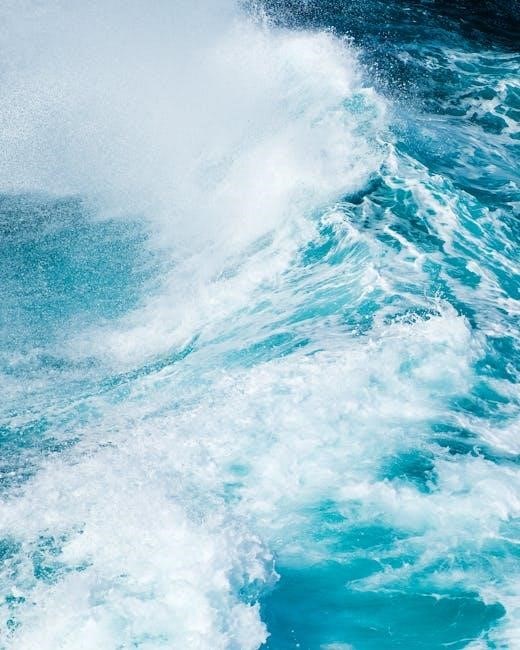The PADI Open Water Diver Manual is a comprehensive guide for beginners, offering detailed insights into scuba diving fundamentals, safety practices, and essential techniques. It serves as the foundation for PADI’s Open Water Diver course, providing learners with a user-friendly resource to master diving skills. The manual is packed with visual aids, clear explanations, and practical applications, ensuring a thorough understanding of diving principles. As the primary training material, it emphasizes safety, proper equipment use, and environmental awareness, making it indispensable for aspiring divers. Always obtain the manual through official PADI channels to ensure authenticity and support proper training practices.
Overview of the PADI Open Water Diver Course

The PADI Open Water Diver course is a structured program designed to teach individuals the fundamentals of scuba diving in a safe and enjoyable manner. It combines theoretical knowledge with practical training, enabling students to develop essential diving skills. The course is divided into three main sections: knowledge development, confined water training, and open water dives. Students learn about diving principles, safety procedures, and equipment usage through the PADI Open Water Diver Manual. Practical sessions in controlled environments, such as swimming pools, allow learners to apply their knowledge. Finally, open water dives provide real-world experience, helping divers build confidence and proficiency. The course emphasizes environmental awareness, responsible diving practices, and the importance of safety protocols to ensure a rewarding experience for all participants.
Importance of the PADI Open Water Diver Manual
The PADI Open Water Diver Manual is a vital resource for scuba diving education, providing a detailed and structured approach to learning. It ensures that divers understand safety protocols, equipment usage, and environmental considerations. The manual serves as a reference guide, offering clear explanations and visual aids to enhance comprehension. By following the manual, students can grasp complex concepts, such as underwater navigation and emergency procedures; Additionally, it emphasizes responsible diving practices, promoting conservation and respect for marine ecosystems. Accessing the manual through official channels guarantees accurate and up-to-date information, which is essential for safe and effective diving. Overall, the manual is indispensable for anyone aiming to become a competent and responsible scuba diver.
Structure and Content of the Manual
The PADI Open Water Diver Manual is organized into five key chapters, each focusing on specific aspects of scuba diving. Chapter 1 introduces the basics of scuba diving, while Chapter 2 emphasizes safe diving practices to prevent accidents. Chapter 3 covers equipment, explaining its proper use and maintenance. Chapter 4 delves into underwater navigation and communication, essential for group dives. Chapter 5 discusses advanced techniques and safety procedures. The manual also includes quizzes and a final exam to reinforce learning. Visual aids like diagrams and illustrations make complex concepts easier to understand. With its logical structure and comprehensive content, the manual ensures that students gain both theoretical knowledge and practical skills necessary for safe diving.

Key Chapters in the PADI Open Water Diver Manual
, Safe Practices, Equipment, Navigation, and Techniques. Each chapter builds on the previous, ensuring a comprehensive understanding of diving essentials.
Chapter 1 introduces the fundamentals of scuba diving, offering an engaging overview of its exciting and rewarding nature. It explains the basics of underwater exploration, highlighting the importance of safety, equipment, and environmental responsibility. This section also delves into diving physics and physiology, helping readers understand how diving affects the human body. Key topics include the principles of buoyancy, breathing underwater, and the essential skills required for a safe diving experience. The chapter emphasizes the role of proper training and certification, encouraging readers to approach diving with respect and caution. It concludes with practical advice on selecting the right equipment and preparing for dives, setting the stage for more detailed chapters ahead.

Chapter 2: Safe Diving Practices
Chapter 2 focuses on essential safety protocols to ensure a risk-free diving experience. It emphasizes the importance of pre-dive planning, buddy systems, and adherence to established safety guidelines. The section explains how to assess risks, monitor conditions, and avoid hazards such as rapid ascents or diving beyond certification limits. Key topics include understanding depth limits, managing air supply, and recognizing signs of decompression sickness (DCS). The chapter also highlights the importance of staying relaxed and maintaining proper breathing techniques to conserve energy and reduce stress. By following these practices, divers can minimize risks and enjoy a safer, more enjoyable underwater experience. This chapter is crucial for building a strong foundation in responsible and safe diving habits.
Chapter 3: Scuba Diving Equipment
Chapter 3 provides a detailed overview of scuba diving equipment, explaining its purpose, functionality, and proper use. It covers essential gear such as masks, snorkels, regulators, BCDs, and tanks, highlighting their roles in ensuring a safe and comfortable dive. The section also discusses the importance of proper fitting and maintenance to prevent equipment failure. Divers learn how to inspect and care for their gear, ensuring reliability underwater. Additionally, the chapter introduces accessories like dive computers, wetsuits, and fins, explaining how they enhance the diving experience. By understanding and mastering the use of this equipment, divers can build confidence and readiness for their underwater adventures. This chapter is vital for preparing students to handle their gear effectively and safely.
Chapter 4: Underwater Navigation and Communication
Chapter 4 focuses on essential skills for underwater navigation and communication. Divers learn how to use a compass, natural landmarks, and distance estimation to navigate effectively. The chapter also covers hand signals and the use of dive slates for clear communication underwater. Proper navigation helps divers stay oriented, avoid getting lost, and return safely to the boat. Effective communication ensures teamwork and safety, allowing divers to share observations or signal for assistance. This section emphasizes the importance of staying together as a group and using visual signals to convey messages clearly. By mastering these techniques, divers can enhance their diving experience and ensure safe, organized dives. These skills are fundamental for building confidence and competence in underwater environments.
Chapter 5: Diving Techniques and Safety Procedures
Chapter 5 delves into advanced diving techniques and critical safety procedures. It emphasizes the importance of proper buoyancy control, streamlined movements, and energy conservation. Divers learn techniques for safe ascents, including gradual rate changes to avoid decompression sickness (DCS). The chapter also covers emergency procedures, such as sharing air and making safe ascents in stressful situations. Properly navigating underwater obstacles and managing dive time are also highlighted. These techniques ensure divers can handle various scenarios confidently. The manual stresses the importance of following safety guidelines to minimize risks and enhance diving experiences. By mastering these procedures, divers can enjoy safer, more enjoyable underwater adventures while protecting themselves and the environment.

Benefits of Using the PADI Open Water Diver Manual
The PADI Open Water Diver Manual offers a comprehensive guide for beginners, providing detailed explanations, visual aids, and practical applications of diving principles. It ensures a strong foundation in safety practices, environmental awareness, and proper techniques, making it an essential resource for aspiring divers. The manual’s structured content helps learners master diving fundamentals efficiently, promoting confident and safe diving experiences. By following the manual, divers gain the knowledge and skills needed to explore underwater environments responsibly. Overall, it is a vital tool for anyone seeking to become a certified PADI Open Water Diver.
Comprehensive Guide for Beginners
The PADI Open Water Diver Manual is specifically designed to cater to newcomers, offering a detailed and structured approach to learning scuba diving. It begins with the basics, such as understanding the equipment, safety procedures, and diving techniques, ensuring that even those with no prior experience can grasp the concepts. The manual includes clear explanations, step-by-step instructions, and visual aids to make complex topics accessible. Additionally, it covers essential aspects like underwater navigation and communication, preparing divers for real-world scenarios. Each chapter builds upon the previous one, creating a logical progression of skills and knowledge. By the end of the manual, beginners are well-prepared to apply their newfound understanding in practical diving situations, making it an invaluable resource for anyone starting their diving journey.
Visual Aids and Detailed Explanations

The PADI Open Water Diver Manual is renowned for its extensive use of visual aids, including diagrams, photos, and illustrations, which simplify complex diving concepts. These visuals complement the detailed explanations, making it easier for learners to grasp critical information. Each chapter is enriched with clear, step-by-step instructions and practical examples, ensuring that divers understand both the theory and its application. The manual’s design caters to various learning styles, with images and charts breaking down topics like equipment assembly and underwater navigation. Such comprehensive visual and textual support enhances knowledge retention and prepares divers for real-world scenarios. By combining visuals with detailed explanations, the manual ensures that learners can confidently apply their knowledge during training and beyond. This approach makes it an indispensable tool for both independent study and instructor-led training.
The PADI Open Water Diver Manual bridges theory and practice by offering real-world applications of diving principles. Each concept, such as buoyancy and navigation, is supported by exercises and scenarios that simulate actual diving conditions. Learners can apply theoretical knowledge through confined water training and open water dives, reinforcing skills like equipment assembly and emergency procedures. The manual encourages divers to think critically, linking classroom lessons to practical experiences. This hands-on approach ensures that divers are well-prepared to handle various underwater situations confidently. By integrating theory with practice, the manual provides a robust foundation for safe and enjoyable diving experiences. It emphasizes the importance of continuous learning and skill refinement, making it a vital resource for divers at all levels. The practical focus ensures that divers can apply their knowledge effectively in real diving environments. The PADI Open Water Diver Manual is protected by copyright, and unauthorized distribution is illegal. Always obtain materials through official PADI channels to ensure compliance and support ethical training practices. The PADI Open Water Diver Manual and its content are protected under international copyright laws. Ownership of the material resides solely with PADI, and any unauthorized reproduction or distribution is strictly prohibited. Accessing the manual through official channels ensures compliance with legal standards and supports the ethical practices promoted by PADI. Diver training materials are carefully crafted to provide accurate and safe diving knowledge, and their integrity must be maintained. Using unauthorized copies not only violates copyright but also risks exposing learners to incomplete or inaccurate information. Always obtain PADI materials through certified instructors or official PADI websites to ensure authenticity and contribute to the preservation of high-quality diver education. Proper training and certification are essential for safe and competent scuba diving. The PADI Open Water Diver Manual emphasizes the need for structured learning to ensure divers understand and apply safe practices. Without proper certification, divers risk exposure to unsafe conditions and potential accidents. Training with a PADI-certified instructor guarantees that learners master essential skills and knowledge, adhering to industry standards. Certification verifies a diver’s competence, allowing them to dive responsibly and confidently. Unauthorized training materials, such as pirated manuals, may omit critical safety information, endangering both the diver and others. Investing in official PADI training ensures a safe and enjoyable diving experience while upholding ethical diving practices worldwide. Unauthorized distribution of the PADI Open Water Diver Manual violates copyright laws and undermines the integrity of PADI’s training programs. Sharing or downloading pirated versions deprives PADI of revenue needed to maintain high training standards. Divers using unauthorized materials risk missing critical safety information, which can lead to accidents. Instructors and dive centers may face legal action for supporting or using illegally distributed content. Certification earned through improper means may be revoked, damaging a diver’s credibility. Supporting official channels ensures the manual’s quality and safety standards are upheld, protecting both divers and the diving community; Respecting intellectual property is essential for maintaining trust in PADI’s certification process. The PADI Open Water Diver Manual is available through authorized PADI Dive Centers or instructors. Digital and print versions can be purchased directly, ensuring authenticity and proper training support. Dive centers often provide the manual as part of the course materials, while instructors guide learners through its content. This official access ensures learners receive accurate, up-to-date information, crucial for safe and effective diving practices. Always obtain the manual through legitimate channels to support PADI’s commitment to diver education and safety standards. The PADI Open Water Diver Manual is exclusively available through authorized PADI Dive Centers, Resorts, or Instructors; Digital versions can be purchased directly from PADI’s official website, while print copies are distributed by certified dive centers. These channels ensure the manual’s authenticity and compliance with PADI’s safety and educational standards. Learners enrolling in the Open Water Diver course typically receive the manual as part of their course materials. Instructors guide students through the content, ensuring proper understanding and application of the material. Accessing the manual through official channels guarantees up-to-date information and supports PADI’s commitment to diver education and safety. Always avoid unauthorized sources to prevent outdated or incorrect information. PADI Dive Centers and Instructors play a pivotal role in providing the Open Water Diver Manual, ensuring learners receive authentic, up-to-date materials. Instructors guide students through the manual, offering expert insights and clarifying complex concepts. Dive centers often bundle the manual with course enrollment, ensuring seamless access to necessary resources. Their expertise helps students apply theoretical knowledge practically, enhancing diving skills and safety awareness. Through hands-on training and personalized support, PADI professionals ensure learners master the material, preparing them for safe and enjoyable diving experiences. Engaging with a certified instructor guarantees a comprehensive understanding of the manual’s content and proper implementation of diving techniques, fostering confidence and competence in new divers. Beyond the PADI Open Water Diver Manual, supplementary materials enhance learning and diving preparation. These include the PADI Open Water Diver Multimedia CD-ROM, offering interactive lessons and video tutorials. Instructors often provide additional handouts or access to online platforms for further study. Divers can also benefit from PADI’s library of specialized manuals, such as the Adventures in Diving or Deep Diver manuals, for advanced training. Online resources, like PADI’s website, offer articles, videos, and courses to deepen knowledge. Local dive shops and communities may host seminars or workshops, fostering networking and skill improvement. These resources ensure a well-rounded education, preparing divers for various underwater environments and scenarios. Exploring these tools enhances diver confidence and competence, making diving safer and more enjoyable. The PADI Open Water Diver Manual is essential for safe and effective training. It provides a comprehensive foundation for divers, emphasizing proper techniques and environmental awareness. Obtain it through official channels to ensure authenticity and support proper training practices. The PADI Open Water Diver Manual is an invaluable resource for anyone embarking on their diving journey. It provides a detailed and structured approach to learning, ensuring divers understand both the theoretical and practical aspects of scuba diving. The manual emphasizes safety, proper techniques, and environmental responsibility, making it an indispensable guide for beginners and experienced divers alike. Its comprehensive content, combined with visual aids, ensures a thorough understanding of diving principles. By following the manual, divers can build a strong foundation for safe and enjoyable underwater experiences. Always obtain the manual through official PADI channels to ensure authenticity and support ethical diving practices. After reviewing the PADI Open Water Diver Manual, aspiring divers should enroll in the PADI Open Water Diver course. This program combines theoretical knowledge with practical training, allowing learners to apply what they’ve studied. Find a PADI-certified dive center or instructor to guide you through the course. They will provide hands-on experience and ensure you meet safety standards. Complete the training to earn your certification, which opens the door to exciting diving opportunities worldwide. Remember, proper training and certification are essential for safe and enjoyable diving experiences. Take the next step today and embark on your journey to becoming a confident scuba diver!Practical Applications of Theoretical Knowledge

Legal and Ethical Considerations

Copyright and Ownership of PADI Materials
Importance of Proper Training and Certification
Consequences of Unauthorized Distribution


Accessing the PADI Open Water Diver Manual
Official Channels for Obtaining the Manual
Role of PADI Dive Centers and Instructors
Additional Resources for Diver Education
Final Thoughts on the Importance of the Manual
Next Steps for Aspiring Divers

